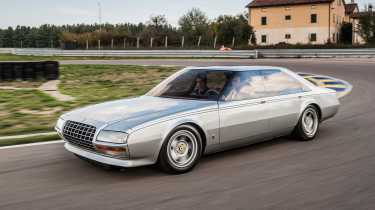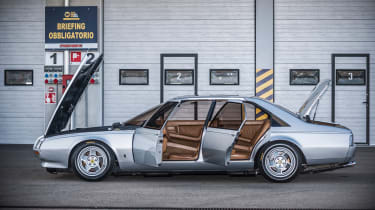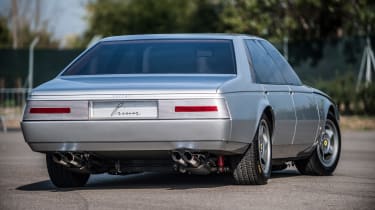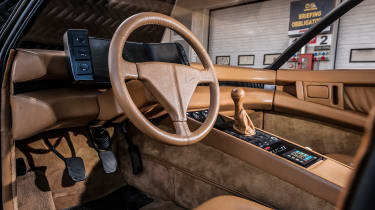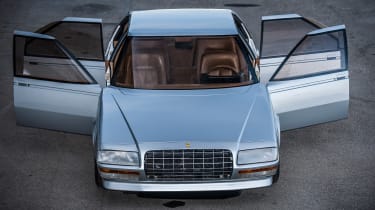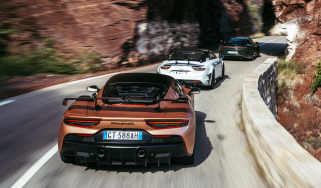The story of the Ferrari Pinin – Pininfarina's 50th Birthday present to itself
Back in 1980, Pininfarina’s 50th birthday present to itself was this remarkable concept for a four-door Ferrari, powered by a flat-12 engine. This is its story
Few styling houses have such a long and distinguished history as Pininfarina, and none has a closer association with Ferrari. So when Pininfarina bosses decided to produce a concept car to mark their company’s 50th birthday in 1980, it had to be something extraordinary, and it had to be a Ferrari. The Ferrari Pinin – named after founder Battista ‘Pinin’ Farina – was that car.
It was Sergio Pininfarina, Battista’s son and by then head of the company, who dreamed of creating a Ferrari-badged rival to the new wave of high-performance high-prestige saloons, which included the Aston Martin Lagonda, Mercedes 450 SEL 6.9 and, most of all, the Maserati Quattroporte, whose third generation had been designed by arch rival Giorgetto Giugiaro’s Italdesign.
There was a real buzz in the run up to the 1980 Turin motor show. On the streets of the Piedmont capital you could hear the rumours that the city’s design house had prepared something special, but no-one really knew what to expect. You’d certainly have got long odds on a four-door Ferrari, for there had been nothing like it in the marque’s history and Enzo’s opposition to anything with more than two doors was well known. So imagine the intake of breath when the curtains dropped and a Ferrari limousine became a fact. Positioning it with some of Pininfarina’s most famous models of the past – classic Alfas and Cisitalias – only served to make it appear even more shocking and otherworldly.
> The GTO Engineering Squalo is a sub-1000kg Ferrari 250 SWB recreation
In 1980, the Pinin was genuinely revolutionary, not just for the extra pair of doors, but also because of an extravagantly futuristic approach to styling. It was by Diego Ottina, who would later contribute to the Testarossa and 348, under the supervision of Leonardo Fioravanti. Looking at the Pinin, you can clearly see Fioravanti’s hand in its angular lines, reminiscent of Ferrari’s 2+2s of the time. The connection between the regular production models and the Pinin was more than skin deep. As with the recently introduced 400i, the Pinin had a transaxle transmission, with a five-speed manual gearbox mounted between the rear wheels. The new car was also surprisingly close in size to the 400i: despite the extra doors, it was only a couple of centimetres longer overall, and the differences in height and width were even less. Its low, wide stance was a world away from mainstream early-80s saloons.
But it was far from being a remodelled 400i. Pininfarina redesigned sections of the chassis and, while the 400i used the evergreen V12 engine, the Pinin had the flat-12 usually found in the Berlinetta Boxer (and, later, its Testarossa successor) as well as in various competition cars: the Pinin was the only model in Ferrari history to have this engine installed in front of the driver.
In truth the flat-12’s competition roots (it was initially conceived for F1, where it would power the multiple championship-winning 312T) didn’t really fit with the idea of a limousine. It was favoured over the V12 because it allowed a far lower and more dramatic-looking bonnet-line. Pininfarina didn’t worry too much about noise or vibration for the simple reason that there were then no plans to move the Pinin project beyond the mock-up stage. Consequently the engine wasn’t even connected to the transmission.
The Pinin’s job was to showcase the design studio’s vision and flair, and this it did spectacularly well. The motoring world had rarely seen such a slick interpretation of the wedge motif in a ‘three-box’ body, while the details were a fascinating old-meets-new mix. Textbook GT proportions, two twin ANSA exhaust tips and a traditional egg-crate grille brought to mind Ferraris of yore, but here they were combined with stylistic features that were genuinely forward-looking.
Many of these look fresh even today. The A- and B-pillars were black to create the visual effect of one uninterrupted strip of glass around the cabin. The five-spoke wheels looked like traditional Speedlines but were shaped to draw cooling air onto the brakes. And in pursuit of the lowest drag coefficient possible the windows were bonded onto the body rather than mounted in the usual way, while the windscreen wipers were hidden behind the bonnet when not in use.
Computer-developed variable light lens technology had been mastered by Lucas just in time to allow the Pinin to have smaller and more streamlined headlights than its contemporaries, but it was the rear lights that stole the show. These were tinted in the same silver hue as the body, the manufacturer, Carello, incorporating several layers of lenses that channelled the light in various ways to give it red, orange, or white colours. Many of the patents that had their debut in the Pinin one-off later made their way onto better-known Pininfarina creations, including the Testarossa and F512M, Cadillac Allanté, Alfa Romeo 164 and Peugeot 405.
> Ferrari Dinos go head-to-head – 246 GT v 206 GT
Inside, traditional Connolly leather was used to clad cabin architecture that was utterly unlike that of any production Ferrari. The screen surrounding the analogue Veglia-Borletti speedometer stayed perfectly black right up to the moment of starting the engine, when it burst into life with an array of function lights and auxiliary gauges. Most of the buttons and knobs had been moved to the central tunnel, while ventilation was limited to concealed slots that spanned the whole width of the cabin.
Rear passengers had individual power seats with a memory function, a hi-fi with personal headphones, a trip computer showing average speed and expected time of arrival, a keyboard, a telephone and individually controlled air-conditioning. And all this in the year that the Triumph Acclaim made its debut. To today’s eyes, the Pinin’s interior clearly belongs to the Duran Duran era, but still it’s impossible not to be impressed by the richness of the surroundings, while the tech must have created a huge wow factor in 1980.
After its Turin debut, the car did the rounds of motor shows and made several visits to the US, with the clear aim of exploring the sales potential for such a car in the North American market – Ferrari’s biggest at the time and the place where a mix of four doors and Italian exotica had probably the best chance of succeeding. Some commentators also read into it clues to the expected replacement for the ageing 400 model line.
Back in Italy, the Pinin’s fate was being determined behind the red doors of il Commendatore’s Fiorano office. With him were his closest collaborators from the road car side of the business: Claudio Sguazzini and Vittorio Ghidella, delegated to Maranello by the Fiat emperor, Gianni Agnelli. Ultimately it was Ghidella’s reluctance that terminated the project.
He had strong arguments on his side, including the slow sales of the Pinin’s strategic competitors and the huge costs that the development of a premium limousine would involve, especially for a company that had virtually no experience with cars of that type. As anyone who had experienced a Mondial or BB512i could tell you, at that time Ferrari’s strengths did not lie in cabin build quality or refinement; it would have taken the company decades to meet the industry standards in these areas. Ghidella preferred to invest the money in new city cars, such as the Panda and Uno, which were much-needed by Fiat at the time. His opinion didn’t meet too much opposition; even Ferrari himself wasn’t sure about the huge challenge of putting the Pinin into production.
The red light from Ferrari meant that Pininfarina had to put the Pinin on the shelf, and there it stayed until, in 1993, it caught the eye of a Ferrari legend, the former racer turned team manager turned Ferrari Belgium importer, Jacques Swaters. The ex-Ecurie Francorchamps star acquired the Pinin to join his unique collection, which included such rarities as the GTO Evoluzione and 250 GT California. As with all his cars, Swaters registered his new acquisition, even though it was still no more than a rolling sculpture. And so the Pinin was given its first registration plate – 20263 – on the isle of Guernsey in September 1999.
Nine years later, and at the grand age of 82, Swaters decided to sell part of his collection at the ‘Leggenda e Passione’ auction held by RM Auctions in Modena. There, lot #220, entitled ‘1980 Ferrari Pinin Prototipo’ – still a non-running mock-up with the boxer engine loosely attached to the rest of the powertrain – fetched the sum of €176,000. The car found its new home not far from Modena, and one might have thought that, 28 years after its inception, the Pinin’s story had come full circle. In fact, it was just the beginning of its new life.
The car had been bought by Gabriele Candrini, manager of one of the most respected classic Ferrari dealerships in the world, Maranello Purosangue, whose premises lie just outside the famous Ferrari factory gate at Via Abetone Inferiore. Gabriele was determined to give the Pinin the life it had always deserved: the life of a fully functional, state-of-the-art performance limousine.
Luckily he had the means to realise his dream, having at his disposal none other than Mauro Forghieri, original architect of the flat-12 racing engine among his many other achievements. Since the mid-90s, the ex-Scuderia Ferrari technical director had been spending his ‘retirement’ in the Oral Engineering consultancy firm that he’d co-founded. Though he was by then in his 80s, many sleepless nights and several hundred thousands euros later, he helped achieve Gabriele’s goal.
In order to bring the Pinin into life, the duo had to buy another Berlinetta Boxer engine and adapt it to its new chassis, merge it into a working unit with the gearbox and transaxle, design wiring and cooling systems and install a fuel tank. Finally, they decided to implement the self-levelling suspension that had been spoken about at the time of the car’s debut.
> Ferrari 812 'Competizione' confirmed – hardcore V12 berlinetta returns
Their efforts reached fruition in March 2010 and the Pinin was ready to move under its own power for the first time, three decades after its debut. Now in fully operational guise, it was put on sale with a price tag of €1,000,000. After failing to find a customer for that sum, in October 2011 it was submitted to RM Auctions once again, this time for a London sale at a more realistically judged price of £500,000. Even then, though, the car didn’t meet the market’s interest and it came back to Maranello Purosangue’s headquarters, from where it was eventually bought by an American collector.
Just before the only four-door Ferrari in history departed Italy, we had a chance to test it on the Autodromo di Modena (the car having still not been road-registered). Even in the less-than-ideal conditions of a race-track, it’s soon evident that Forghieri has done a fine job in achieving the full limousine effect that the Pinin’s extravagant lines and sumptuous interior promise. That interior really is a good place to be, and the gentle suspension setup ensures it flows across the tarmac. As light floods the vast greenhouse, interrupted only by the thinnest of pillars, it’s a fascinating mix of a classic Italian GT and ’80s tech-laden premium car.
To add to this already slightly surreal experience, the tranquil ambience is regularly torn apart by a flat-12 Ferrari engine transmitting its 365 horsepower to the rear wheels with almost racecar-like ferocity. You just learn to accept it as part of the Pinin’s unique character, although there are still some issues that would make driving it on an actual road tricky at best. It’s still a prototype, after all, and the space taken up by the engine and its peripherals mean the steering system has a limited ability to turn left. What’s more, the driver would need to be constantly on the look-out for any sudden bumps or dips because of the extremely low ground clearance, the consequence of the engine being pushed down by the low bonnet.
All these issues would, of course, have been addressed had the Pinin progressed to a production prototype. And after spending a day with this car you can’t help but think of it as of a missed opportunity. From behind the Pinin’s wheel it’s not difficult to imagine an alternative history of Ferrari with a four-door Lagonda rival coming off the Maranello production line. Against all odds, a Ferrari limousine might just have worked.
Back in the real world, Ferrari has so far stayed true to making only coupés and convertibles, but, in the light of Sergio Marchionne’s recent comments, in all likelihood we won’t need to wait another four decades for the next exception to the two-door rule.
This feature first appeared in Enzo issue 4.
